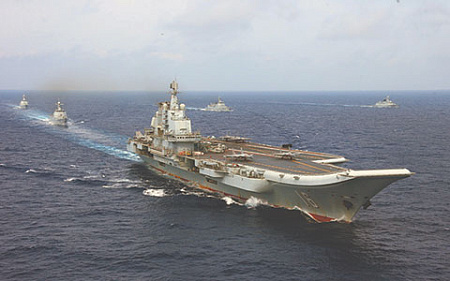
The Chinese aircraft carrier group entered the waters of Japan and, after leaving them, conducted exercises. Alarmed by the growing military might of China and North Korea, Tokyo is deploying missiles on islands close to these countries. This is done with the approval of the United States, which maintains naval ships and units of other branches of the Armed Forces in Japan. But many Japanese are not satisfied with the policy of militarization of the country, they also doubt Washington’s obligations. Such sentiments are especially strong in Okinawa, where the United States maintains a military contingent of 25,000 people.
In Okinawa, the year 2025 and the year 1945 are closely intertwined. The fact is that one of the bloodiest battles in the Pacific Ocean took place on this island. About 200 thousand people died then. These were American and Japanese soldiers, as well as about 90,000 civilians. Tokyo, unlike Berlin, has not explicitly acknowledged its responsibility for unleashing World War II. But Okinawans have not erased it from their memory. Moreover, the current US military base was built, as researcher Justin Mercury writes in The Guardian newspaper, on the remains of victims of those fierce battles. The islanders protested many times against the deployment of American troops, one of them even went on a hunger strike. But the voices of the protesters in Tokyo and Washington did not want to be heard.
Meanwhile, tensions in the region are rising. On the one hand, Tokyo and Washington are deploying missiles on the Japanese islands capable of striking China, North Korea and Russia. America, Japan and South Korea regularly conduct joint military exercises. During their course, an American aircraft carrier, permanently stationed in Japan, was repeatedly moored in South Korea. American bombers capable of carrying nuclear weapons flew over the territory of South Korea.
In Pyongyang, these actions are perceived as a direct threat to the very existence of the DPRK. Therefore, missile systems are being tested there. Pyongyang also stated that the DPRK possesses nuclear weapons and will not give them up under any circumstances.
This is the background against which Beijing sent the Liaoning aircraft carrier and its accompanying two missile-equipped destroyers and a logistics vessel to the shores of Japan. The aircraft carrier group entered the exclusive economic zone of Japan and for the first time approached the island, which is considered the most advanced Japanese land to the east. Tokyo expressed its concern and informed China about it. Japanese Cabinet Secretary General Yoshimasa Hayashi said: “We will do everything possible to fulfill our duties to warn and monitor what is happening at sea and in the air.”
Japan had previously adopted an evacuation plan for 100,000 residents from the islands closest to Taiwan. This should be done in the event that a military conflict breaks out there. And now there is another reason for alarm in Tokyo and Washington. After all, China has sent its ships to that part of the ocean, which is located only 300 km from the Japanese island of Minomitori.
Meanwhile, Tokyo is concerned not only about the threat to its security, but also about the state of its wallet. Deposits of rare metals have been discovered on the seabed near Minomitori. Mining them in the future could bring profits to Japanese private companies and contribute to the receipt of fees to the state budget.
Minomitori is uninhabited. However, the posts of the Ministry of Defense and the Meteorological Service are installed on it. However, the Chinese ships soon left the economic zone of Japan themselves and began to conduct exercises.
In addition to the conflict between Beijing and Tokyo, near Minomitori, the two powers have been arguing for the Senkaku Islands (Diaoyu) in the East China Sea for more than 10 years. These uninhabited islands are under the control of Japan, but China believes that this archipelago belongs to it.
And yet, according to The New York Times, the Pentagon and the Japanese military are sending the most resources to Okinawa. According to Kazuo Suzuki, director of the Institute of Geoeconomics in Tokyo, Japan’s plan “A” is that the United States will fulfill its obligations in the event of war with China and use forces stationed in Okinawa to retaliate. But we also need a plan B in case US President Donald Trump makes a non-intervention deal with Beijing. Then Japan will have to ensure its own security on its own.
From this we can conclude that the defense relations between Tokyo and Washington are not as reinforced as they look on the surface.
